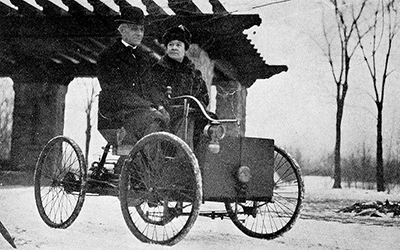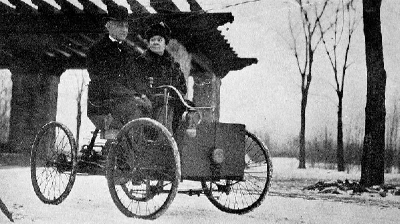Billion-dollar motorway flyover

Takes just 3.43 minutes to ‘fly’ the preferred route. The New Zealand Transport Agency’s simulated flyover of the preferred route deserves high praise for vividly and dramatically illustrating the magnitude of what is involved in building a motorway from Pūhoi to Warkworth.
Notable are the vast cuttings and colossal viaducts involved. And the lack of tunnels—the route slices along the sides of major landforms, rather than through ’em, as in the Ōrewa–Pūhoi section of the motorway.
Strangely, the simulation fails to show details such as a Woodcocks Road overpass, raising speculation that rural traffic would be diverted to Kaipara Flats Road.

Old as the Bicycle: Electrical engineer Henry Ford built his car, the Quadricycle, only a decade after the invention of the chain-driven bicycle. image Wikimedia Commons
In summary, it’s a beguiling invitation to go down the wrong road—the road to ruining the northern green belt and a hastening of the general headlong gallop into runaway global warming.
If I had asked people what they wanted, they would have said faster horses.
Henry Ford’s first car, the Quadricycle, more reflected the immensely popular chain-driven bicycle, which had emerged a mere decade earlier, rather than some horseless carriage. While ‘faster bicycles’ may have been more germane, it would not have illustrated the point Ford presumably wished to make: His style was to imagine and design for the future, not be led by nose by the hoi polloi.
Planning further motorway is today’s equivalent of the faster horse. The infrastructure that the transport agency should be building is that which uses a fraction of the energy needed for rubber-wheeled vehicles, and is not fossil-fueled. Countries that continue to invest in yesterday’s fossil fuel infrastructures are going to bankrupt themselves before they can begin building low energy, clean energy alternatives. The United States is fast being outstripped by China and India in developing clean energy, resulting in a rapidly changing world order.
Aotearoa should be striving to rebuild a reputation as clean, green and smart. Hitting the headlines for harming tourists, grotesque farm practices, poorly-regulated fossil fuel mining, and an appalling road toll is something the country should strenuously avoid.
An estimated 50 people will die in crashes on the existing highway between Pūhoi and Wellsford by 2022, the provisional completion date of the planned motorway.
Rather than blow billions on motorway construction, Operation Lifesaver is an alternative proposed by the Campaign for Better Transport, at an estimated cost of $320 million. The work could be completed and saving some five lives a year, before the projected motorway start date of 2012.
The safety upgrade involves bypasses for Warkworth and Wellsford, and something more substantial than double– yellow lines to prevent head-on collisions.

Straight‑Talking Aussies: The unambiguous instruction Australians receive at the end of passing lanes reduces room for confusion or prevarication—left lane traffic must merge right, right lane traffic must yield.
The proposal deserves to be depicted by a simulated flyover every bit as shiny as that of the transport agency. This would readily illustrate important details of the proposal, such as extending the Pōhuehue Viaduct to allow the passing lane to continue uninterrupted—eliminating one point of inherently fraught merging. Aotearoa, incidentally, should adopt the Australian practice of requiring traffic in the slow lane to merge with traffic in the fast. While it is clearly an imposition on traffic dutifully keeping left, it is unambiguous and inherently safer. The consequences of a vehicle in the left lane not being permitted to merge are far less dire than if a vehicle in the passing lane is given nowhere to go, and all-too-fatally being propelled into the opposing traffic.
But the Campaign for Better Transport’s proposal deserves a better name, if it is to compete with ‘holiday highway’ for attention. The coining of holiday highway was a stroke of brilliance equal to the alliteration and derisiveness of ‘super city’. The terms, however, also share a descriptiveness that Operation Lifesaver largely lacks. The Mahurangi Magazine has resiled from using either term, partly through a desire to avoid even partial misnomers, but ultimately because of the inherent negativity.
It sometimes helps to bullet-point key aspects:
- Save 50 lives
- Take two years, not 12
- At a fraction of the price
- Pūhoi–Wellsford
Regardless of whether the name can be improved, the proposal should be the rallying cry for those who oppose northward extension of the motorway, whether it be the $1.7–2.3 billion cost, the carbon dioxide contribution, the potential loss of motorway access to Pūhoi and Mahurangi West, exacerbation of the region’s sprawl, or a number of other very valid concerns. While it might be easier to rally some with a ‘stop Steve’s motorway madness’ chant, ultimately it is more constructive to promote a positive, readily achievable alternative.
The next consideration is whether a comprehensive transport plan could be promoted. Upgrading the Northland railway line and building the link to Marsden Point could be achieved quickly. It speaks volumes of Steven Joyce’s prejudice against rail that he has failed to nail his colours to the mast of the Marsden Point link, which has had all the planning hard-yards put in by KiwiRail Network, the infrastructure arm of the New Zealand Railways Corporation.
The other crucially important infrastructure for Northland is trail, for cyclists and walkers. Cycling north of Ōrewa is not for the timid. The terrain is gruelling and the highway distinctly inhospitable. Trail with rail solves this and would measurably contribute to the economy north of the metropolis. (The cost–benefit ratio of the planned motorway is so poor as to have been buried, until unearthed by the Green Party.)
Finally, it is difficult to judge whether it is wise to dignify the planned motorway with opposition. With Aotearoa’s external debt at record levels, sooner or later the government will begin the process of lowering expectations for the Pūhoi–Wellsford motorway. A vigorous, well-organised campaign might hasten the demise of the plan, or it might back the National Party into a fiercely determined corner—an additional reason to go hard for a positive alternative:
North Road Rail with Trail.
